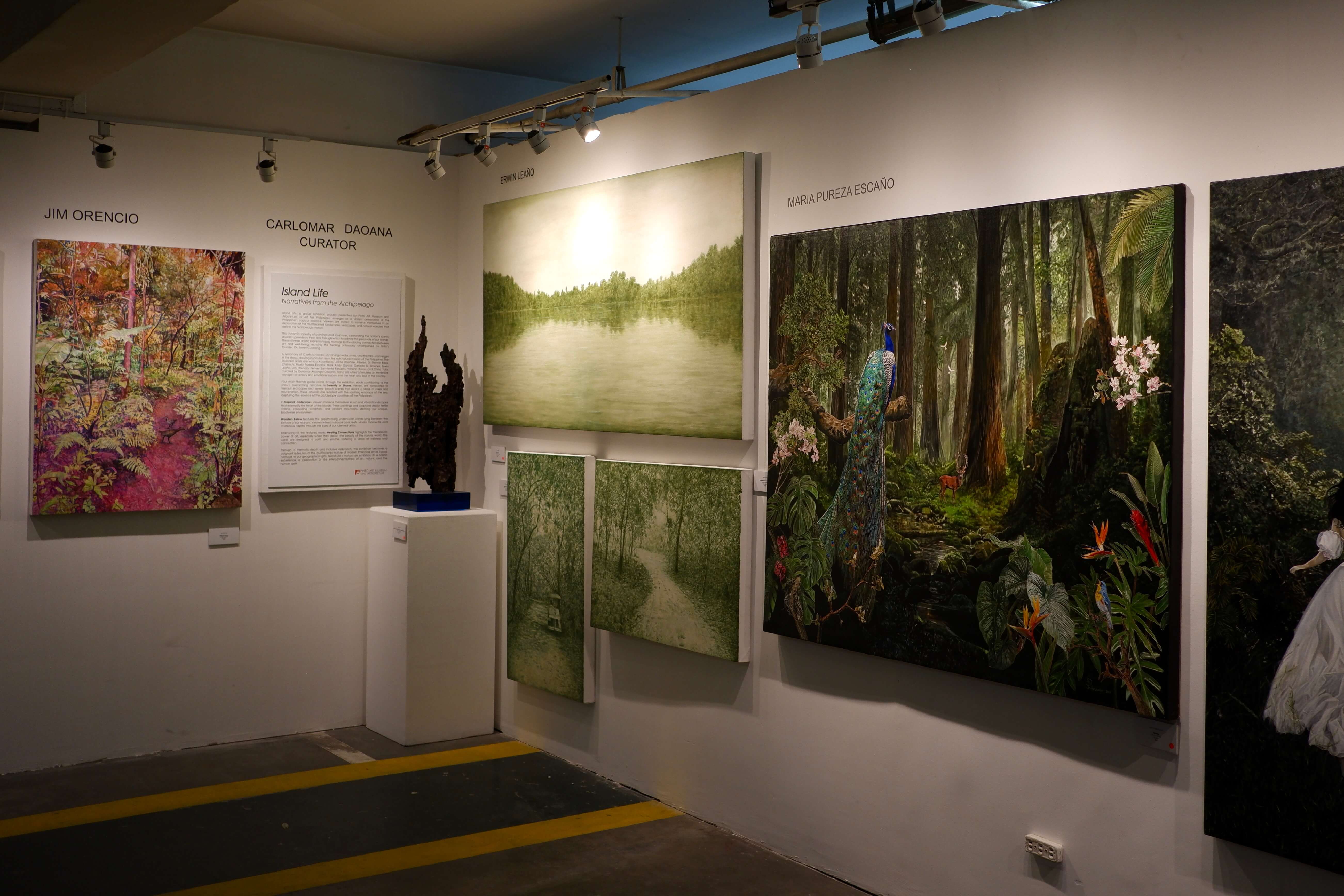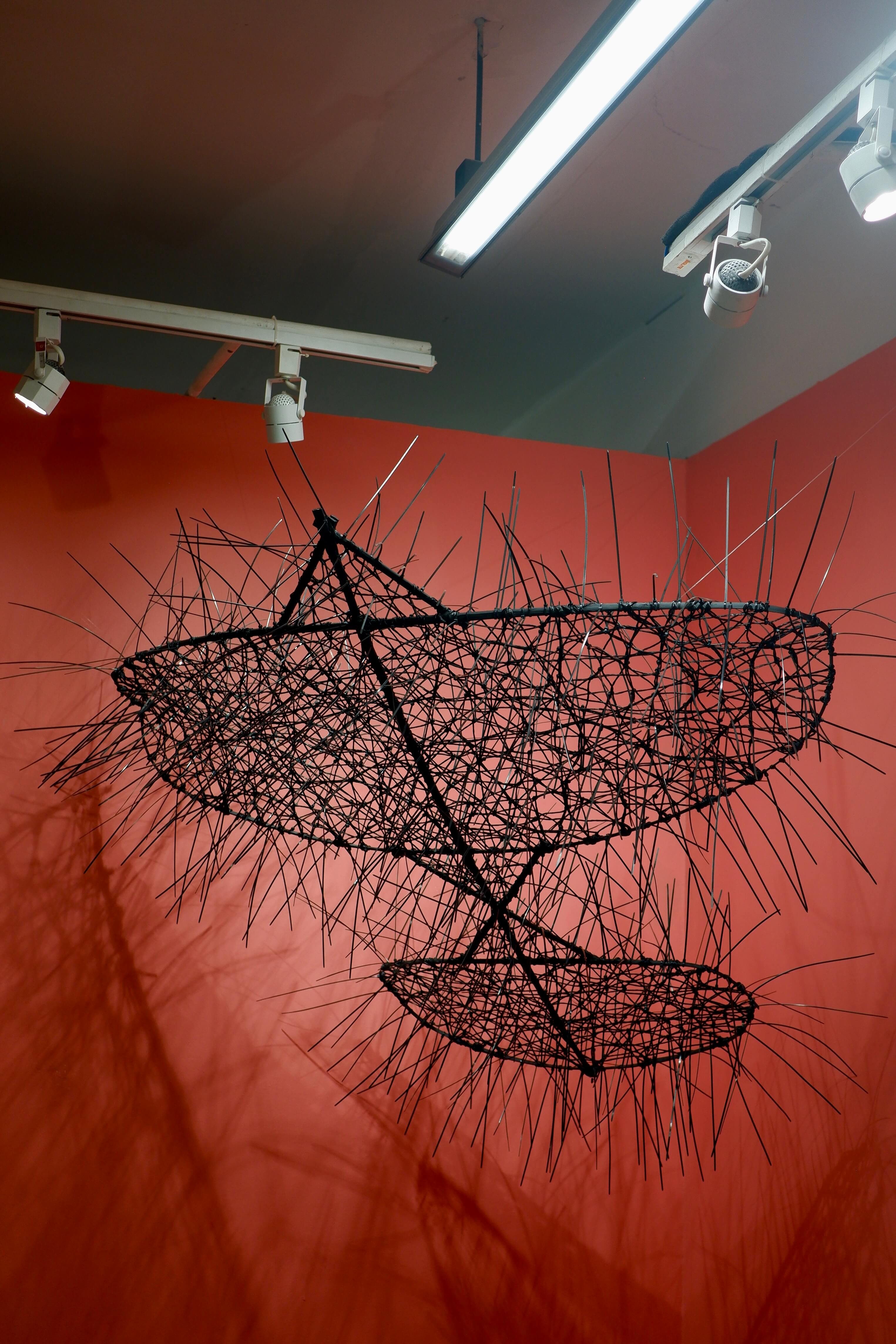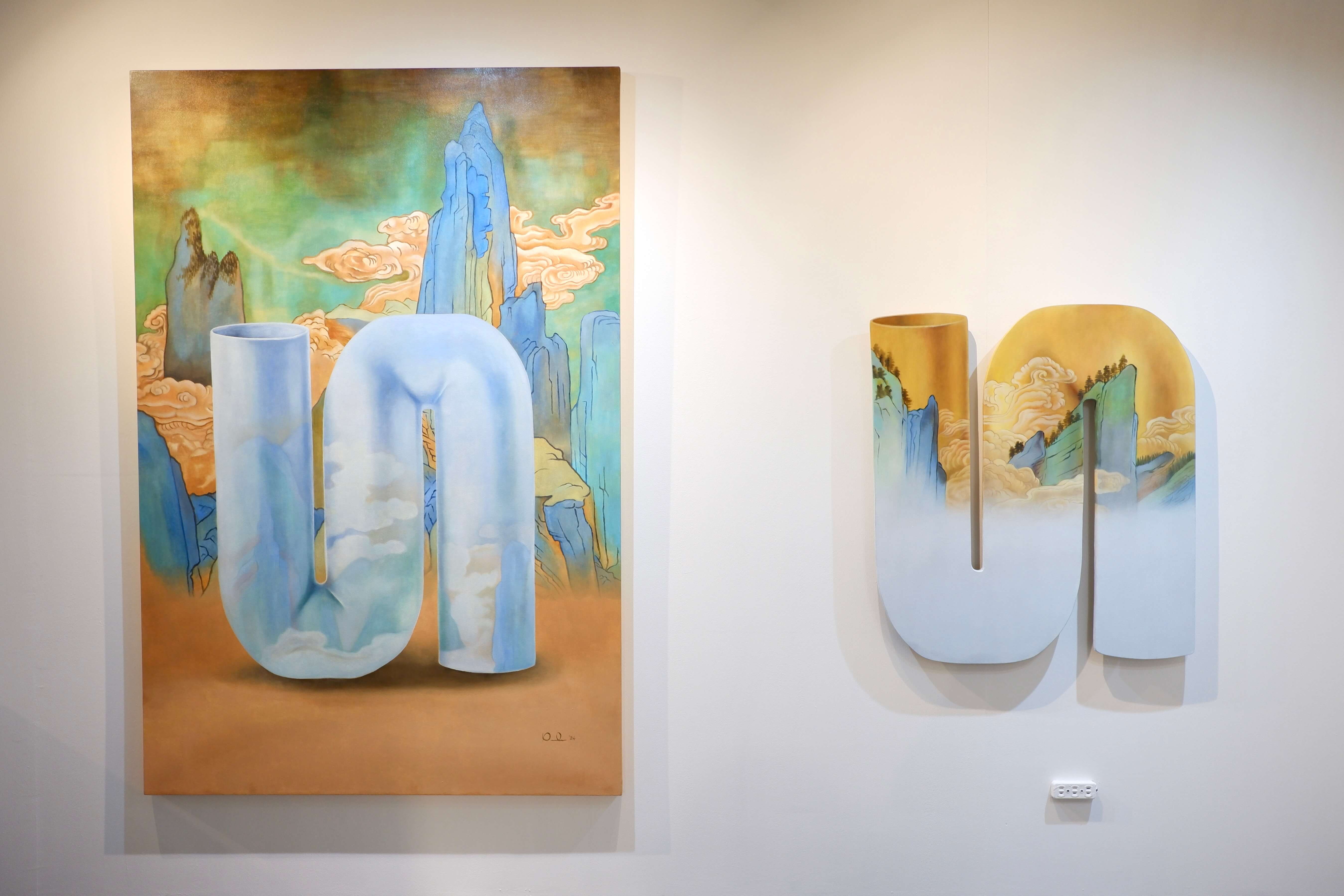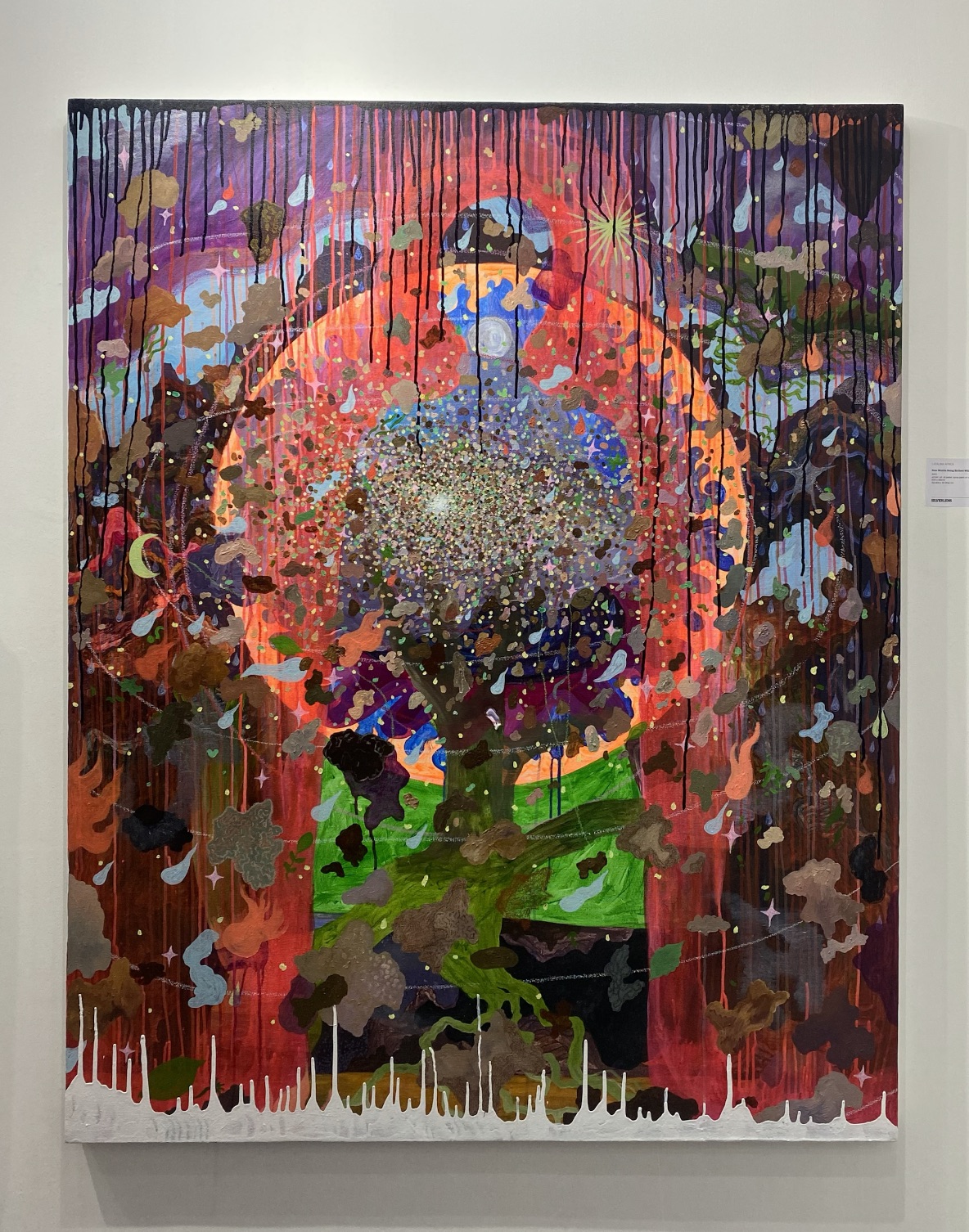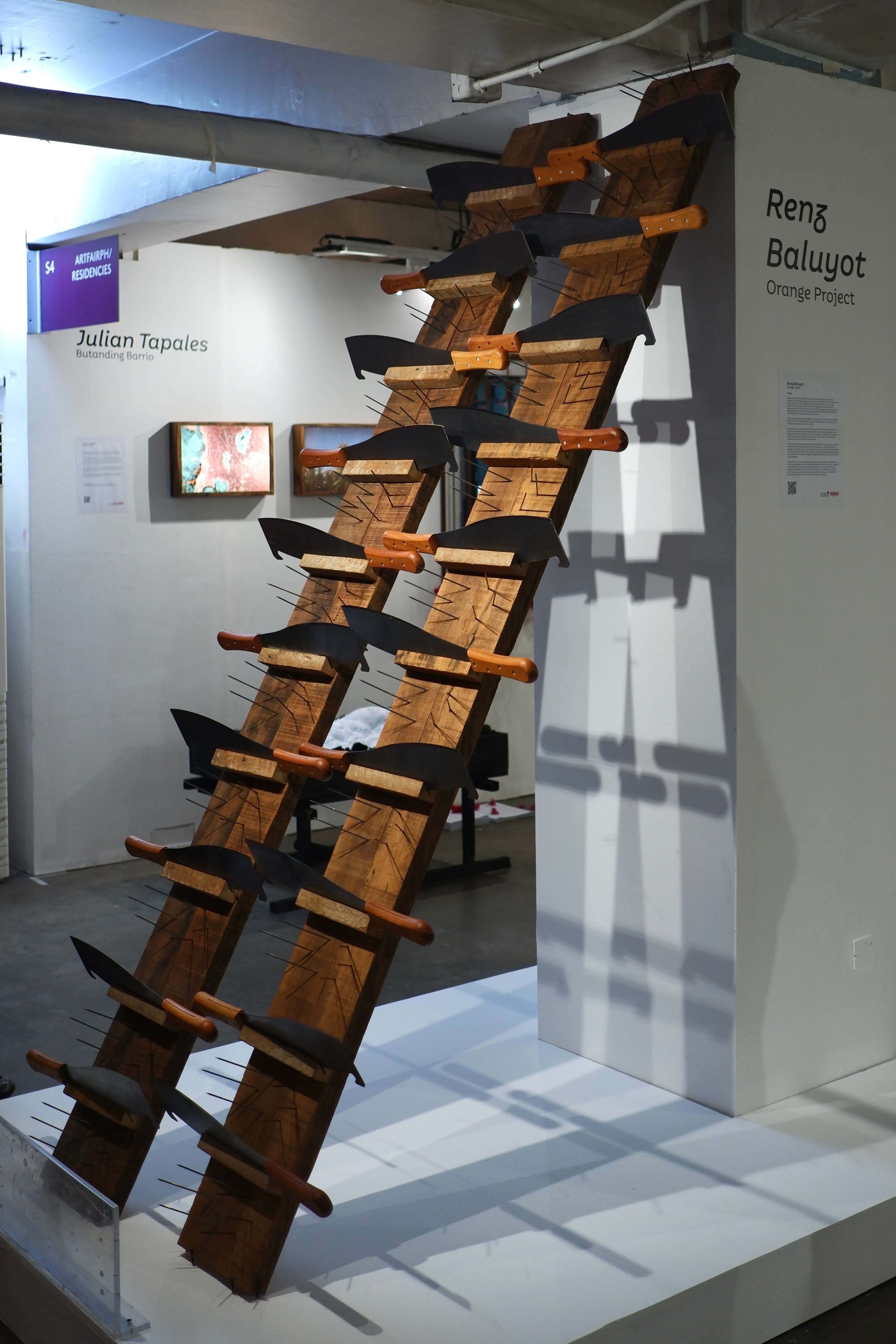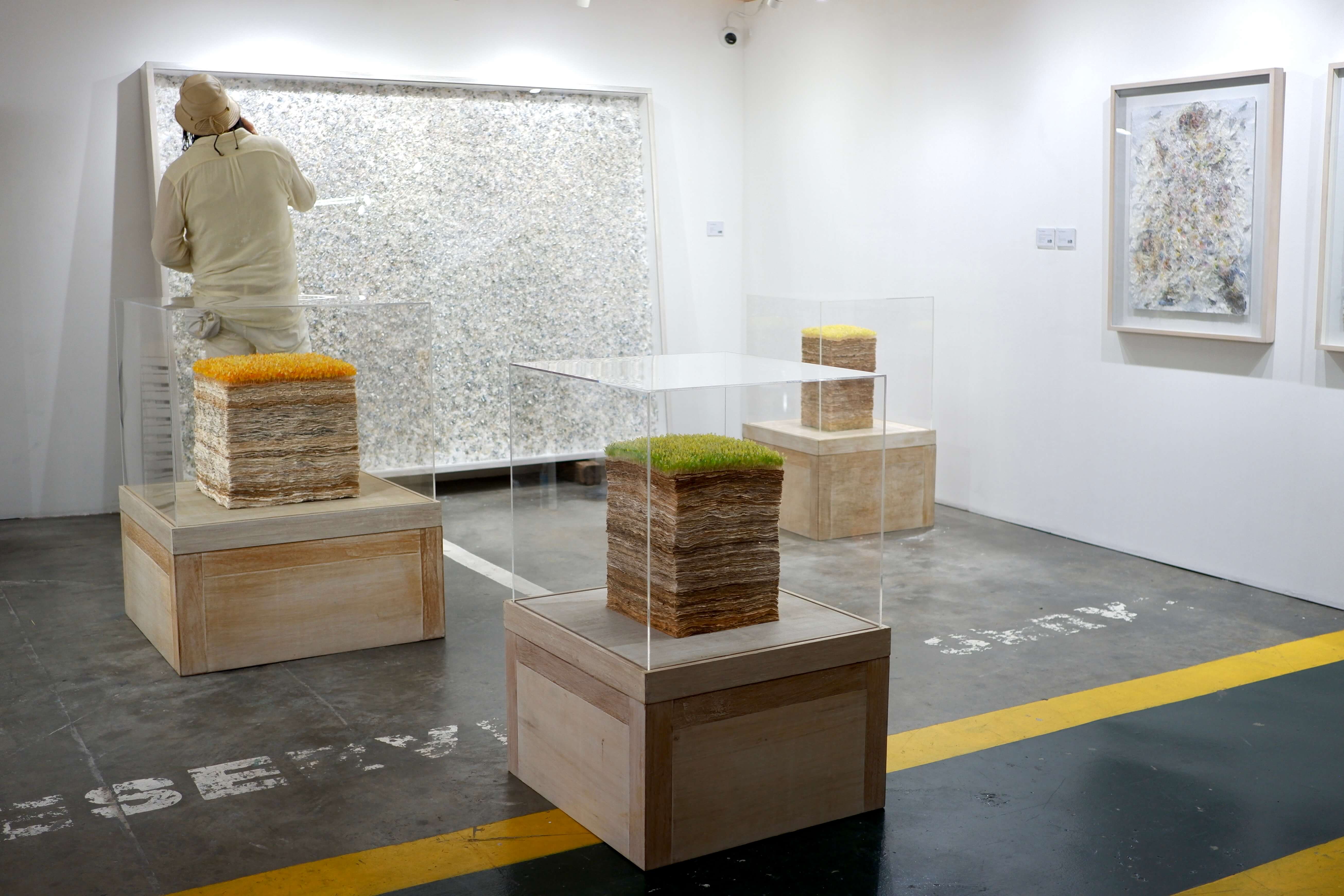Art Fair Philippines is sprawling in scope. The fair kicks off the National Month of the Arts every February and hosts exhibitors and guests from Southeast Asia and beyond. This year, 55 exhibitors mounted paintings, sculptures, and every object in between across four floors at The Link in Makati. AFP, as endearingly called in art communities, often hints at rising currents that run through the art world for the rest of the year.
In 2024, AFP exhibitors spotlighted works that explore physical, cultural, and emotional landscapes. Antipolo-based Pintô Art Museum set up Island Life, a showcase of large paintings that revel tropical lusciousness. Meanwhile, the Center for Art, New Ventures & Sustainable Development (CANVAS) showed sculptures, paintings, and illustrations that reflect on environmental issues in their exhibit If Trees Could Talk. In addition to booth-specific shows, several individual artworks across AFP grapple with the landscape in all its forms.
Here are some pertinent patterns and artworks that concentrate on this theme:
Internal vs. External Landscape
Philippines-based artists Yandra Po and Catalina Africa explore contrasts between the natural environment and one’s emotional landscape through their large-scale paintings.
Yandra Po’s solo exhibit at the Ysobel Art Gallery booth, In All the Ardent Earth, delves into Chinese landscape painting. The tradition of Chinese landscape painting focuses on representing an artist’s character and intellect more than accurately depicting the landscape. In a painting, the artist organizes trees, mountains, clouds, and rivers to represent one’s internal terrain.
Po leans into the reflective quality of the tradition. Her paintings booth feature a Chinese landscape painting set as a backdrop against a piece of pottery. Parts of the paintings reflect on the surfaces of these containers. Some paintings even break away from the usual rectangular form and take the shape of squiggly vessels. Po toys with the contrasts between form, color, and texture.
Yet, Po’s playfulness in In All the Ardent Earth betrays a deep poignancy. As elucidated in the exhibition text by Prim Paypon, Po pays homage to her family’s history as Chinese immigrants to the Philippines. The artist’s exploration of Chinese landscape painting in In All the Ardent Earth allows her to see the genre develop in a contemporary context. Here, the landscape not only moves from the internal to the external, but also across time and generations.
Similarly, Catalina Africa explores the tension between internal and external landscapes through her mixed-media painting, New Worlds Being Birthed Within at Silverlens’s booth. Africa eschews pointed messaging and focuses on transporting the viewer into a realm teeming with energy and color. To achieve this, the artist pulls from a confluence of references: Fauvism, 1970s counterculture, and tropical horror vacuii. With these influences on hand, Africa delves into the transcendental aspects of communing with the land.
In New Worlds Being Birthed Within, Africa plants a tree at the center of the composition, which perhaps alludes to creationism stories spanning Judeo-Christian to pre-colonial Filipino tradition. Orbiting the tree are painterly fragments, which lend the overall composition a cosmic gravitas. But amid the furor of Africa’s painting, one can make out a human hovering behind the tree. Here, Africa portrays the symbiosis between humanity and nature, that one cannot be birthed without the other.
By transporting viewers into this liminal space, Catalina Africa harkens back to the practice of humanity finding meaning and connection in nature. 19th-century Transcendentalist writer Henry David Thoreau sought to find the equilibrium between societal and natural living. Thoreau spoke of “the tonic of wildness,” which he searched for during his two-year stay at Walden Pond in Massachusetts. But, perhaps, if Thoreau lived today, he needn’t venture out that far. With a little help from Catalina Africa’s New Worlds Being Birthed Within, Thoreau could have found this mystical space within himself.
Found Objects and Materials
Beyond manipulating paint and pigments to shape the land, a handful of artists at AFP use found objects and materials to recreate a sense of place. Renz Baluyot, Alfredo & Isabel Aquilizan, and Oca Villamiel all wield found, salvaged, and repurposed materials to create impressions of their landscapes.
Renz Baluyot’s sculpture, Pureza, at the Orange Project residency section, focuses on the experience of sugarcane farmers in Negros Occidental. Baluyot names his sculpture after the harvesting age sugarcanes reach for better yields. In Pureza, Baluyot lays farming knives, “espading,” on each rung of a ladder used by local farmers, “damyo.” Sack needles pierce through the ladder, rendering them not only incapable of use but also threatening. Baluyot’s Pureza paints an ominous picture of the sugarcane trade and the plight farmers face as they till the land. By using found materials, Baluyot introduces a sense of immediacy to the viewers and urges them to reflect on the processes that transmute land to material to food.
In parallel, Alfredo & Isabel Aquilizan explore themes of labor and displacement through their exhibit, Dwellings, at The Crucible Gallery’s booth. For this exhibit, the artists collected and repurposed scrap cardboard to create sculptures. In the Philippines, the humble cardboard box is often associated with balikbayan boxes sent by Overseas Filipino Workers (OFW) from all over the world to their families back home. These boxes are filled with goodies, like snacks and clothes, that testify to an OFW’s dedication to their families. Alfredo & Isabel Aquilizan fashioned these sculptures to resemble buildings — dwellings if you will. The artists highlight the contrast between distance and domesticity to show a third, liminal space.
At Richard Koh Fine Art’s booth, Oca Villamiel’s three sculptures, Shine Down, Great Sun, On Flowers and Fields I-III, stand inside glass vitrines. Upon first glance, these sculptures resemble perfect slices of earth. Light brown and beige layers stack upon one another, while what seems like dried grass sits atop of these stacks. Yet, on closer inspection, one discovers that the crust is a pile of aged textbooks and the grass is parakeet feathers. The meticulous arrangement of materials here reflects Villamiel’s practice of archiving and adapting material to different contexts. Unlike Baluyot and Aquilizan, Villamiel opts to preserve rather than deconstruct materials.
Technological Interventions
Popular media and discourse often pit nature against technology. However, human society has reached a tipping point where it cannot function without technology. The main question now is how could humans live with nature without sacrificing technological progress. Artists Julian Tapales and Ana Teresa Barboza explore the implications of this question through their works at Art Fair Philippines 2024.
Manila and London-based artist and programmer Julian Tapales presents an installation made during his residency at Butanding Barrio that interrogates mapmaking and surveillance. Throughout history, humans have used maps to find their way back home, to categorize the world around them, and, darkly speaking, to push a geo-political agenda. In his project at Butanding Barrio, Tapales took photographs of Ille Cave, which contains evidence of early cremation. He then translated these 2D images into 3D models using a technique called Photogrammetry. Weeks of research culminates in an installation at AFP that includes a video, a sculpture, photographs, and documentation.
Tapales’ endeavors at Butanding Barrio open a Pandora’s box of questions about the role technology plays in both surveying land and making art. How accurate are digital tools given the amount of human editing needed for them to work? And, what role does the artist play when craft is delegated to a machine?
Peruvian artist Ana Teresa Barboza investigates the limits of digital and analog media through her mixed-media tapestry, Manantial Barraquinto, at NUNU Fine Art’s booth. Manantial Barrquinto depicts a rock formation through a high-resolution digital photograph that morphs into an alpaca wool weaving. On one hand, the photograph reveals every pore, every dimple of the stone, yet is flat and glossy to the touch. Conversely, the textile only hints at the rocks’ colors but introduces tactility to simulate the feeling of touching rocks. But, when placed together, the two materials create a fuller portrait of the land.
Through Manantial Barraquinto, Barboza holds space for contemporary and traditional modes of image-making. She compels the viewer to consider how the medium — and consequent manipulation — of images affects comprehension of the subject.
Reshaping The Land
Art Fair Philippines 2024 consolidates exhibitors at the intersection between the art world and the wider, global culture. This year’s broad focus on landscapes reveals a new tendency to look outward as much as inward. Perhaps, this newfound concentration stems from years of being indoors during lockdowns and isolations. Or, perhaps, it speaks to general anxieties surrounding displacement, climate change, and technological advancement. The artists’ explorations of landscapes show the variegated approaches to different concerns.
But, what’s most interesting about the works and objects at AFP is that they’re not landscapes at all. They are constructed, edited, and curated depictions of natural landscapes. René Magritte’s aphorism in The Treachery of Images, “Ceci n’est pas une pipe” (This is not a pipe) captures the spirit of AFP this year. An artist’s hand could transform a mountain into an heirloom, an island paradise into a battleground, and a cave into lines of code. This ability speaks to the influence artists wield today.
The current culture of juggernaut art fairs, mass information, and social media imbues images with so much potency. Images shape the way we view our landscape, which in turn affects the way we interact with the world around us.
--------
Madeleine is a designer and writer based in Manila.
--------
All photographs by the author.

